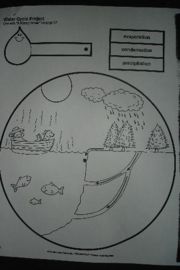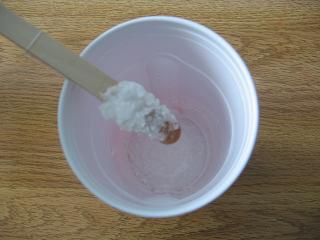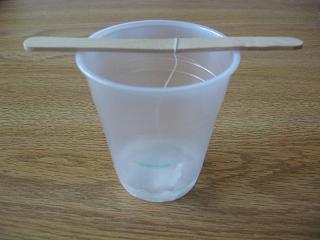Evaporation in the Water Cycle
| Instant wiki maker | Making handouts | Editing tips |
Contents
- 1 Student worthiness
- 2 Primary biological content area covered
- 3 Materials
- 4 Handouts
- 5 Description of activity
- 6 Lesson plan
- 7 Must Do
- 8 Potential pitfalls
- 9 Music connections
- 10 Literature connections
- 11 Health connections
- 12 Chemistry connections
- 13 Connections to educational standards
- 14 Next steps
- 15 Citations and links
- 16 Reflection
Biology In Elementary Schools is a Saint Michael's College student project from a course that ran between 2007 and 2010. The student-created resources have been preserved here for posterity. Link under 'toolbox' for printer-friendly versions of the exercises. Click on handouts to print full resolution versions. Please see Wikieducator's disclaimer, our safety statement, and the Creative Commons licensing in English and in legalese.
Student worthiness
Tried once by us and worked well.
Primary biological content area covered
The students will get an understanding on the stages of the water cycle and will be able to visually see how water evaporates while salt, a solid at room temperature, does not.
Materials
Student group materials:
- Clear Plastic Cups
- Salt
- Teaspoon
- Tablespoon
- Black marker
- Food Coloring
- Water Cycles by Jon Adam
- Relf, Pat, 1996 The Magic School Bus Wet All Over: A Book About The Water Cycle Scholastic Inc.
Individual student materials:
- Colored Pencils
- Pencil
- Popsicle Sticks
- Water Cycle handout
Handouts
-The first handout that the students will receive is a diagram of the water cycle. The diagram will be labeled but it will be black and white so the students can color it in. This will get them to see the processes of the water cycle visually rather than just hearing the definitions of the certain terms.
Description of activity
Students will be introduced to the water cycle by coloring in a diagram and learning about the terms on that diagram. After the students understand these terms, they will go on to sing a short little song that will get them engaged in learning the different stages of the water cycle. After the broad understanding of the whole water cycle is complete, a focus will start on evaporation because it seems hard for young students to visualize water turning into water vapor and evaporating. The experiment involving evaporation is a great way for students to visualize that the water actually does turn into vapor. Each student will be given a plastic cup filled 1/4 of the way with water and a small portion of salt to mix into the water. The students will then place their individual cups by the window because the water needs sun and heat to evaporate. After a few days, the students can check back to the cups, noticing that the water has evaporated and the salt crystals are left over.
Lesson plan
1. The teacher will read Water Cycles by Jon Adam to the class.
2. Students will color a diagram of the water cycle with the terms already listed on it and also discuss the chemistry connections.
3. The teacher will go over the different terms on the diagram with the students, explaining them so that each student understands them.
4. The students and teacher will then sing Water Travels Around the Cycle, Yes it Does with hand movements to engage the students and contribute to their understanding of the stages.(See musical connections for words and tune).
5. The teacher will pass out individual cups and salt, and students will write their names on them. The teacher will then pour a small amount of water into each cup (about 2 tablespoons), mark the water level on the cup with the sharpie, and then pour 1 teaspoon of salt into the cups. Allow students to add food coloring, just for fun.
6. The students will then place one end of a popsicle stick into their cups so that part of the stick is emerged in the water.
7. The students will place the cups by the window and wait until the end of the day to check back on the cups. There may not be visible change in the first or second day but by the end of the week, there should be a noticeable amount of water evaporated and salt accumulated on the popsicle sticks.
8. The teacher will discuss with the students how the water has evaporated from the cup and the salt crystals have been left behind, and discuss how the water turned in to water vapor and evaporated.
9. The teacher will explain the health connections related to the water cycle.
10. To conclude, the students and teacher will sing Water Travels Around the Cycle, Yes it Does to review their new knowledge about the water cycle.
Must Do
- Keep colored pencils sharpened.
- Pour water into a pitcher before the lesson to save time when filling students' cups.
- Don't add too much water - the more you add, the longer it will take to evaporate.
- Allow the students to choose their own food coloring but the teacher should be in charge of adding it.
- Have a pre-made cup (with the water evaporated and remaining salt crystals) to show the students what theirs will look like after their water has evaporated.
Potential pitfalls
Lack of sunlight and cold temperatures will slow evaporation.
Music connections
Water Travels Around the Cycle Yes it Does song.
To be sung to the tune of "She'll be Coming Around the Mountain".
The lyrics are as follows: Water travels in a circle yes it does! Water travels in a circle yes it does! It goes up as evaporation. Forms clouds as condensation. then falls down as precipitation. Yes it does!
Literature connections
The Magic School Bus Wet All Over by Pat Relf
Water Cycles by Jon Adam
Martin, Jacqueline, 1998 "Snowflake Bentley" Houghton Mifflin Company Literary Connection It's snowing
Health connections
99% of your own sweat is water. Just as a lack of rain can result in a drought on land, when someone doesn't drink enough water they can become dehydrated. It is important to stay hydrated, especially in warm weather when one is participating in out door activities.
Chemistry connections
1. Matter is made up of atoms.
2. Atoms get together and form molecules.
3. Molecules are always moving, and the move even faster when you add heat to them.
4. This motion causes the molecule bonds to break away and escape into the air.
Connections to educational standards
S1-2:47 Forces and Changes on the Earth’s Surface
Students demonstrate their understanding of processes
and change over time within earth systems by…
· Creating categories of “things that change” and keeping a
record of them over the school year.
Next steps
1. If we have more time we can cover the cup with plastic wrap and secure it with an elastic. Over time, water will collect on the plastic wrap and students can see condensation. This will allow them to make their own connections and observe other parts of the water cycle.
2. If there is time and student interest, we could read the Magic School Bus book.
3. This experiment also works well when sugar is substituted for salt. Food coloring may be added to make a colorful crystals that will gather on the popsicle stick and the children can feel free to eat their tasty treat.
Citations and links
http://www.proteacher.org
Starr Evers Starr Biology: Today and Tomorrow pg. 20-21
Reflection
- After performing this lab with several different small groups of third graders I have learned that they will indeed find it very interesting. Having a model of the finished product, complete with crystals on the string or Popsicle stick, will boost their enthusiasm. The literature connection, The Water Cycle, lacked the charisma to hold their attention with all of the other commotion going on in the lab. Also, the handout that is made into a diagram of the water cycle has many pieces. While passing out the pieces the attention of the students wavers. Perhaps it would be best to put these materials into ready made packages for the students, or let the students cut the pieces out themselves. Over all, the interest in the activity was high, and it was a lot of fun.
-Julie
- Evaporation is a hard concept for second graders to understand and I think that our lab was a great way for them to learn about it. It was hands-on, which is always better for students to grasp a concept. The salt water in the plastic cup will hopefully allow them to see how evaporation occurs once they put them on their windows in the classroom. It was a little unexciting for the students to set up this experiment because they were not able to see results right away. In order to keep the enthusiasm high, we allowed the students to color their water mixture with a food coloring of their choice. This little step was a great way to keep them involved and excited about the lab. I think that the students were able to understand the three basic steps of the water cycle after they had completed our lab.
-Mary Beth
- A beneficial aspect of our lesson was that we had a book to read to the students which we intended to use to help the students focus before beginning the actual instruction. Even though some of the students didn’t seem particularly interested in the book because of the other distractions going on in the room, it definitely calmed them down a bit. I think it would do much better to read the book in an actual classroom environment. Also, having the pre-made cups on hand was helpful; the students passed the cups around to see the salt crystals and I think that this made them look forward to watching the water in their cups get lower and eventually evaporate, leaving the salt behind. The problems that we ran into were mainly results of time constraints; we had one group after another so we had virtually no time to organize the materials for the next group. We had to move completed water cycle diagrams and cups out of the way, and we constantly needed to sharpen the pencils, so it would definitely be advisable to have more colored pencils or at least a pencil sharpener that can be more easily accessible. Unfortunately, we were unable to work in the musical aspect of the lesson, which was to sing “Water Travels Around the Cycle, Yes it Does” because we ran out of time. Hopefully if this is run in an actual classroom, the teacher won’t be as pressed for time as we were so that keeping everything flowing smoothly and completely won’t be as much of a challenge.
-Janine



